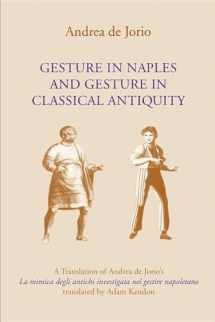
Gesture in Naples and Gesture in Classical Antiquity: A Translation of
Book details
Summary
Description
"I had heard about this book for years. The person who put the word out, at least in lay circles, was probably Luigi Barzini, in The Italians (1964). Praising his countrymen's gift for talking with their hands, Barzini lamented that so little had been written on this subject. To his knowledge, only one person―Andrea de Jorio, a Neapolitan priest―had attempted a lexicon of Italian hand gestures, in an 1832 volume entitled La Mimica degli antichi investigata nel gestire napoletano.... Barzini offered a little sample.... Upon reading [it], you felt that if you could not get hold of de Jorio's book immediately, you would bite your elbows.... [N]ot until this year was de Jorio's treatise brought out in English. The translation, the copious notes, and the long, helpful introduction... [are] a source of wisdom and delight." ―Joan Acocella, New York Review of Books
"The twentieth century found little time for de Jorio's pioneering work until recently, when the rise of semiotics combined with an interest among art historians in gesture to invest his achievement with an importance that not even he could have imagined. Even so, this book has been more often cited than read. In view of its immense relevance to contemporary studies of gesture in the context of language and culture, it is surprising that we have had to wait so long for a translation into English. Adam Kendon has now given us the first complete, annotated rendering of [de Jorio's book]. Kendon himself is an established leader in the new scientific approach to the study of gesture." ―G.W. Bowersock, The New Republic
Andrea de Jorio's La mimica degli antichi investigata nel gestire napoletano (‘Gestural Expression of the Ancients in the light of Neapolitan gesturing'), was first published in Naples in 1832. It soon became famous for its descriptions and depictions of Neapolitan gestures, but it is only with the recent expansion of scholarly interest in gesture that its true importance has come to be recognized. It is the first book ever written which presents what is, in effect, an ethnographic study of gesture. Treating gesture as a culturally established communicative code, analogous to language, the book sets out to describe, with reference to an explicitly defined cultural group, the gestural expressions of ordinary people as these are used in everyday life. It also deals with numerous issues important for any semiotics of gesture, such as the question of the relationship between physical form and meaning, the problem of how to present a description of the gestural repertoire of a community in a consistent manner, the importance of context for the interpretation of gesture, how gestures may be combined, how they develop as metaphorical expressions, among many others.
Andrea de Jorio (1769-1851) was a cleric and a Canon of the Cathedral of Naples, but he was also an archaeologist and a curator at the Royal Borbonic Museum (today the National Archaeological Museum) in that city. He was an expert on Greek vases and intimately involved in all aspects of archaeology then developing in relation to the excavations at Herculaneum, Pompeii, Pozzuoli, Cuma and other sites within the district of Naples. He believed that the ordinary people of Naples had preserved in their culture the traditions of the ancient Greek founders of the city. For this reason he supposed that an understanding of contemporary gestural expression would be useful in interpreting the gestures and bodily postures depicted in the frescoes, mosaics, sculptures, and painted vases of Greco-Roman antiquity that had come to light from the excavations near Naples and elsewhere. Thus he was led to describe the gesturing of contemporary Neapolitans as fully as possible.


We would LOVE it if you could help us and other readers by reviewing the book
Book review



